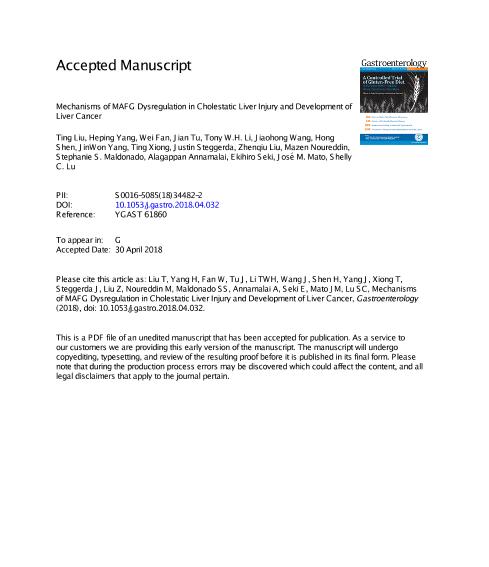
暂无数据~
Heat shock causes diverse changes in the phosphorylation of the ribosomal proteins of mammalian cells 
Abstract When HeLa cells or BHK cells were subjected to heat shock at 42°C (for 2 h) or 45°C (for 10 min) there was extensive dephosphorylation of ribosomal protein S6. Concomitantly ribosomal protein L14, which is not significantly phosphorylated in normal cells, became phosphorylated, as did a non-structural protein of Mr = 27 000, associated with the ribosomes. The latter effects were not prevented by cycloheximide or actinomycin D. When cells shocked at 45°C for 10 min were returned to 37°C for 2 h there was rephosphorylation of ribosomal protein S6 and dephosphorylation of the 27 kDa protein, but not of ribosomal protein L14.

Mechanisms of MAFG Dysregulation in Cholestatic Liver Injury and Development of Liver Cancer 
Background & Aims MAF bZIP transcription factor G (MAFG) is activated by the farnesoid X receptor to repress bile acid synthesis. However, expression of MAFG increases during cholestatic liver injury in mice and in cholangiocarcinomas. MAFG interacts directly with methionine adenosyltransferase α1 (MATα1) and other transcription factors at the E-box element to repress transcription. We studied mechanisms of MAFG up-regulation in cholestatic tissues and the pathways by which S-adenosylmethionine (SAMe) and ursodeoxycholic acid (UDCA) prevent the increase in MAFG expression. We also investigated whether obeticholic acid (OCA), an farnesoid X receptor agonist, affects MAFG expression and how it contributes to tumor growth in mice. Methods We obtained 7 human cholangiocarcinoma specimens and adjacent non-tumor tissues from patients that underwent surgical resection in California and 113 hepatocellular carcinoma (HCC) specimens and adjacent non-tumor tissues from China, along with clinical data from patients. Tissues were analyzed by immunohistochemistry. MAT1A, MAT2A, c-MYC, and MAFG were overexpressed or knocked down with small interfering RNAs in MzChA-1, KMCH, Hep3B, and HepG2 cells; some cells were incubated with lithocholic acid (LCA, which causes the same changes in gene expression observed during chronic cholestatic liver injury in mice), SAMe, UDCA (100 μM), or farnesoid X receptor agonists. MAFG expression and promoter activity were measured using real-time polymerase chain reaction, immunoblot, and transient transfection. We performed electrophoretic mobility shift, and chromatin immunoprecipitation assays to study proteins that occupy promoter regions. We studied mice with bile-duct ligation, orthotopic cholangiocarcinomas, cholestasis-induced cholangiocarcinoma, diethylnitrosamine-induced liver tumors, and xenograft tumors. Results LCA activated expression of MAFG in HepG2 and MzChA-1 cells, which required the activator protein-1, nuclear factor–κB, and E-box sites in the MAFG promoter. LCA reduced expression of MAT1A but increased expression of MAT2A in cells. Overexpression of MAT2A increased activity of the MAFG promoter, whereas knockdown of MAT2A reduced it. MAT1A and MAT2A had opposite effects on the activator protein-1, nuclear factor–κB, and E-box–mediated promoter activity. Expression of MAFG and MAT2A increased, and expression of MAT1A decreased, in diethylnitrosamine-induced liver tumors in mice. SAMe and UDCA had shared and distinct mechanisms of preventing LCA-mediated increased expression of MAFG. OCA increased expression of MAFG, MAT2A, and c-MYC, but reduced expression of MAT1A. Incubation of human liver and biliary cancer cells lines with OCA promoted their proliferation; in nude mice given OCA, xenograft tumors were larger than in mice given vehicle. Levels of MAFG were increased in human HCC and cholangiocarcinoma tissues compared with non-tumor tissues. High levels of MAFG in HCC samples correlated with hepatitis B, vascular invasion, and shorter survival times of patients. Conclusions Expression of MAFG increases in cells and tissues with cholestasis, as well as in human cholangiocarcinoma and HCC specimens; high expression levels correlate with tumor progression and reduced survival time. SAMe and UDCA reduce expression of MAFG in response to cholestasis, by shared and distinct mechanisms. OCA induces MAFG expression, cancer cell proliferation, and growth of xenograft tumors in mice.


暂无数据~

 V4
V4
